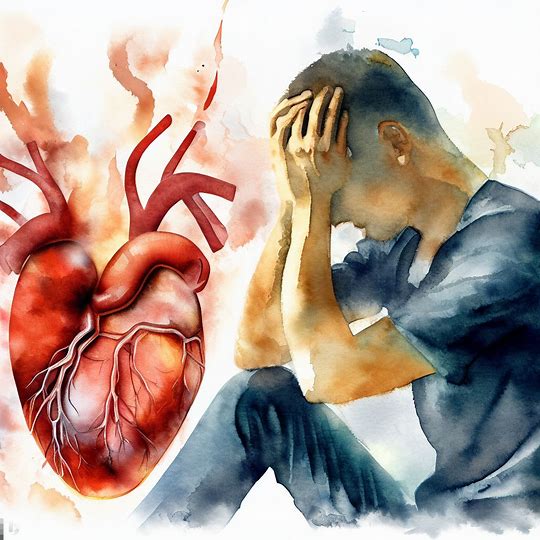Chronic Stress and Hemorrhagic Stroke in Young Adults? Stress may increase the risk of hemorrhagic stroke in young adults. Learn about the research on this link, and what you can do to reduce your risk.
Chronic stress is a common experience for many people, but it can have serious consequences on one’s health, including an increased risk of hemorrhagic stroke. Hemorrhagic stroke is a type of stroke that occurs when a blood vessel in the brain ruptures, causing bleeding in the brain. While hemorrhagic stroke is more common in older adults, it can also occur in young adults, and chronic stress may be a contributing factor.
Research has suggested that chronic stress can lead to high blood pressure, which is a known risk factor for hemorrhagic stroke. Chronic stress can also cause inflammation in the body, further increasing the risk of stroke. In addition, chronic stress may lead to unhealthy lifestyle habits such as smoking, excessive alcohol consumption, and poor diet, which can also increase the risk of stroke.
Overall, it is important to manage chronic stress to reduce the risk of hemorrhagic stroke, especially in young adults. By adopting healthy lifestyle habits such as regular exercise, a balanced diet, and stress-reducing activities like meditation or yoga, individuals can lower their risk of stroke and improve their overall health. Additionally, seeking professional help for chronic stress can also be beneficial.
Table of Contents
Key Takeaways
- Chronic stress can increase the risk of hemorrhagic stroke in young adults.
- Chronic stress can lead to high blood pressure and inflammation, which are known risk factors for stroke.
- Adopting healthy lifestyle habits and seeking professional help can help manage chronic stress and reduce the risk of stroke.
The Relationship Between Chronic Stress and Hemorrhagic Stroke

Understanding the Physiological Effects of Chronic Stress
Chronic stress is a long-term, ongoing stress that can lead to a wide range of physical and psychological health problems. When a person experiences chronic stress, their body releases stress hormones, such as cortisol and adrenaline, which can cause a variety of physiological changes in the body. These changes can include increased blood pressure, inflammation, and changes in blood vessel function.
Exploring the Potential Link Between Chronic Stress and Hemorrhagic Stroke in Young Adults
Hemorrhagic stroke is a type of stroke that occurs when a blood vessel in the brain ruptures and bleeds into the surrounding tissue. This can cause damage to the brain and can lead to a wide range of neurological problems. While there is still much to learn about the relationship between chronic stress and hemorrhagic stroke, some studies have suggested that there may be a link between the two.
One study published in the journal Stroke found that chronic stress was associated with an increased risk of hemorrhagic stroke in young adults. The study analyzed data from over 500,000 participants and found that those who reported high levels of stress were more likely to experience hemorrhagic stroke than those who reported low levels of stress.
Another study published in the journal Neurology found that chronic stress was associated with an increased risk of vascular conditions, including hemorrhagic stroke. The study analyzed data from over 6,700 participants and found that those who reported high levels of stress were more likely to experience vascular conditions than those who reported low levels of stress.
While these studies suggest a potential link between chronic stress and hemorrhagic stroke in young adults, more research is needed to fully understand the relationship between the two. It is important to note that other factors, such as high blood pressure, can also increase the risk of hemorrhagic stroke, and that stress may be just one of many factors that contribute to the development of this condition.
In conclusion, chronic stress can have a variety of negative effects on the body, including an increased risk of hemorrhagic stroke and other vascular conditions. While more research is needed to fully understand the relationship between chronic stress and hemorrhagic stroke in young adults, it is clear that reducing stress levels and managing stress effectively can have a positive impact on overall health and well-being.
Risk Factors for Hemorrhagic Stroke in Young Adults

Age, Gender, and Genetics as Influencing Factors
Hemorrhagic stroke is a rare but serious condition that can affect young adults. While the risk of hemorrhagic stroke increases with age, it can occur at any age. Men are more likely to experience hemorrhagic stroke than women. Genetics also play a role in the risk of hemorrhagic stroke. Some genetic disorders, such as Moyamoya disease and arteriovenous malformation, increase the risk of hemorrhagic stroke.
Discussing the Role of Chronic Stress as a Risk Factor
Chronic stress has been identified as a potential risk factor for hemorrhagic stroke in young adults. Chronic stress can lead to high blood pressure, which is a major risk factor for hemorrhagic stroke. When blood pressure is consistently high, it can weaken blood vessels in the brain, making them more susceptible to rupture.
Other Medical Conditions That May Increase the Risk
In addition to chronic stress, other medical conditions can increase the risk of hemorrhagic stroke in young adults. These include high cholesterol, obesity, diabetes, pregnancy, tobacco use, hypertension, alcohol consumption, and smoking. Hypertension, in particular, is a major risk factor for hemorrhagic stroke. It is important for young adults to manage these conditions to reduce their risk of hemorrhagic stroke.
Overall, hemorrhagic stroke is a serious condition that can affect young adults. While age, gender, and genetics play a role in the risk of hemorrhagic stroke, chronic stress and other medical conditions can also increase the risk. It is important for young adults to be aware of these risk factors and take steps to manage them to reduce their risk of hemorrhagic stroke.
Chronic Stress and Hemorrhagic Stroke in Young Adults – Sources
- Hemorrhagic Stroke (Bleeds) | American Stroke Association. Available at: https://www.stroke.org/en/about-stroke/types-of-stroke/hemorrhagic-strokes-bleeds
- Risk factors and mechanisms of stroke in young adults: The FUTURE study. Available at: https://www.ncbi.nlm.nih.gov/pmc/articles/PMC6120122/
- Hemorrhagic Stroke: What It Is, Causes, Symptoms & Treatment. Available at: https://my.clevelandclinic.org/health/diseases/23969-hemorrhagic-stroke
- Stroke – Symptoms and causes – Mayo Clinic. Available at: https://www.mayoclinic.org/diseases-conditions/stroke/symptoms-causes/syc-20350113
Managing Chronic Stress to Reduce the Risk of Hemorrhagic Stroke

Chronic stress can have a significant impact on a person’s physical and mental health, including increasing the risk of hemorrhagic stroke in young adults. Fortunately, there are several ways to manage chronic stress and reduce the risk of stroke.
Recognizing and Addressing Stress Triggers
The first step in managing chronic stress is recognizing and addressing stress triggers. This involves identifying the situations, events, or people that cause stress and finding ways to either avoid them or cope with them more effectively. Some common stress triggers include work-related stress, financial stress, relationship problems, and health issues.
Implementing Effective Stress Management Techniques
Once stress triggers have been identified, it’s important to implement effective stress management techniques. These can include relaxation techniques such as deep breathing, meditation, and yoga, as well as regular exercise, healthy eating habits, and getting enough sleep. It’s also important to take breaks throughout the day and engage in activities that bring joy and pleasure.
Seeking Professional Help and Support
In some cases, chronic stress may require professional help and support. This can involve speaking with a doctor or mental health professional to develop a treatment plan that may include medications, therapy, or rehabilitation. The American Heart Association recommends seeking help if stress is affecting daily activities or causing physical symptoms such as headaches, fatigue, or difficulty sleeping.
Incorporating Stress-Reducing Activities into Daily Life
Finally, it’s important to incorporate stress-reducing activities into daily life. This can include hobbies, spending time with loved ones, and engaging in physical activity. The American Heart Association recommends engaging in at least 150 minutes of moderate-intensity aerobic exercise per week to reduce stroke risk.
By recognizing stress triggers, implementing effective stress management techniques, seeking professional help and support when necessary, and incorporating stress-reducing activities into daily life, it’s possible to manage chronic stress and reduce the risk of hemorrhagic stroke in young adults.
Chronic Stress and Hemorrhagic Stroke in Young Adults – Sources
- American Heart Association: Stress and Heart Health
- National Stroke Association: Stress and Stroke
- Mayo Clinic: Stress Management
Conclusion

Chronic stress is a serious issue that affects many people, and it can have a significant impact on their overall health. While there is evidence to suggest that chronic stress can increase the risk of stroke, particularly ischemic stroke, there is no clear evidence to suggest that it can cause hemorrhagic stroke in young adults.
According to a review of the literature by the Radiological Society of North America, ischemic strokes in young adults are increasingly frequent and devastatingly debilitating. Stroke remains the leading cause of serious disability in the United States, and its consequences in this atypical age group are especially detrimental and long-lasting. However, there is no clear link between chronic stress and hemorrhagic stroke in young adults.
A study published in the American Heart Association’s Stroke journal found that post-traumatic stress disorder (PTSD) is associated with a significant increase in the risk of early incident transient ischemic attacks (TIA) and ischemic stroke independent of established stroke risk factors, coexisting psychiatric disorders, and healthcare utilization. However, sex moderated the relationship for adults with ischemic stroke but not TIA.
Another study published in the same journal found that stress-related primary intracerebral hemorrhage may be caused by a sudden rise in blood pressure/cerebral blood flow, mediating small-vessel fibrinoid necrosis and rupture. This or a related mechanism may underlie many small-vessel strokes.
While chronic stress can have a significant impact on overall health, there is no clear evidence to suggest that it can cause hemorrhagic stroke in young adults. It is important to manage stress and seek medical attention if you experience any symptoms of stroke, such as sudden weakness, numbness, or difficulty speaking.
Frequently Asked Questions
What are the symptoms of a hemorrhagic stroke caused by stress?
Symptoms of hemorrhagic stroke caused by stress may include sudden severe headache, weakness or numbness on one side of the body, difficulty speaking, confusion, vision problems, and loss of coordination or balance. It is important to seek medical attention immediately if you experience any of these symptoms.
What are the risk factors for hemorrhagic stroke in young adults?
Young adults who experience chronic stress may be at increased risk for hemorrhagic stroke. Other risk factors for hemorrhagic stroke include high blood pressure, smoking, heavy alcohol consumption, drug use, and certain medical conditions such as diabetes.
What are some preventative measures for hemorrhagic stroke caused by stress?
Preventative measures for hemorrhagic stroke caused by stress may include stress management techniques such as meditation, exercise, and therapy. Maintaining a healthy lifestyle by eating a balanced diet, getting enough sleep, and avoiding smoking and excessive alcohol consumption can also help reduce the risk of hemorrhagic stroke.
What is the relationship between chronic stress and hemorrhagic stroke in young adults?
Chronic stress has been linked to an increased risk of hemorrhagic stroke in young adults. Stress can cause changes in blood pressure and blood vessel function, which can increase the risk of a hemorrhagic stroke.
What are the long-term effects of hemorrhagic stroke caused by stress?
The long-term effects of hemorrhagic stroke caused by stress can vary depending on the severity of the stroke and the individual’s overall health. Some individuals may experience long-term disability or cognitive impairment, while others may make a full recovery.
How is hemorrhagic stroke caused by stress treated?
Treatment for hemorrhagic stroke caused by stress may include medications to control blood pressure and prevent blood clots, surgery to repair or remove damaged blood vessels, and rehabilitation to help individuals regain lost function. It is important to seek medical attention immediately if you experience symptoms of a hemorrhagic stroke.
